Preventing Failure to Rescue: Nursing Strategies & Patient Safety
VerifiedAdded on 2022/09/09
|5
|861
|15
Essay
AI Summary
This essay critically evaluates two nursing strategies—the Acute Deterioration Detection System (ADDS) chart and patient/family education—aimed at preventing registered nurses from failing to rescue deteriorating patients in acute healthcare environments. The ADDS chart facilitates early identification of clinical deterioration through continuous observation and coded vital signs, enhancing quick response times. Patient and family education empowers patients to participate in their care, recognize potential medical errors, and advocate for their safety, while also equipping family members to notice deterioration and ensure continuity of care post-discharge. The essay emphasizes that successful implementation of these strategies relies on nurses' appropriate use of ADDS and effective delivery of patient education, ultimately enhancing patient safety and quality of care.
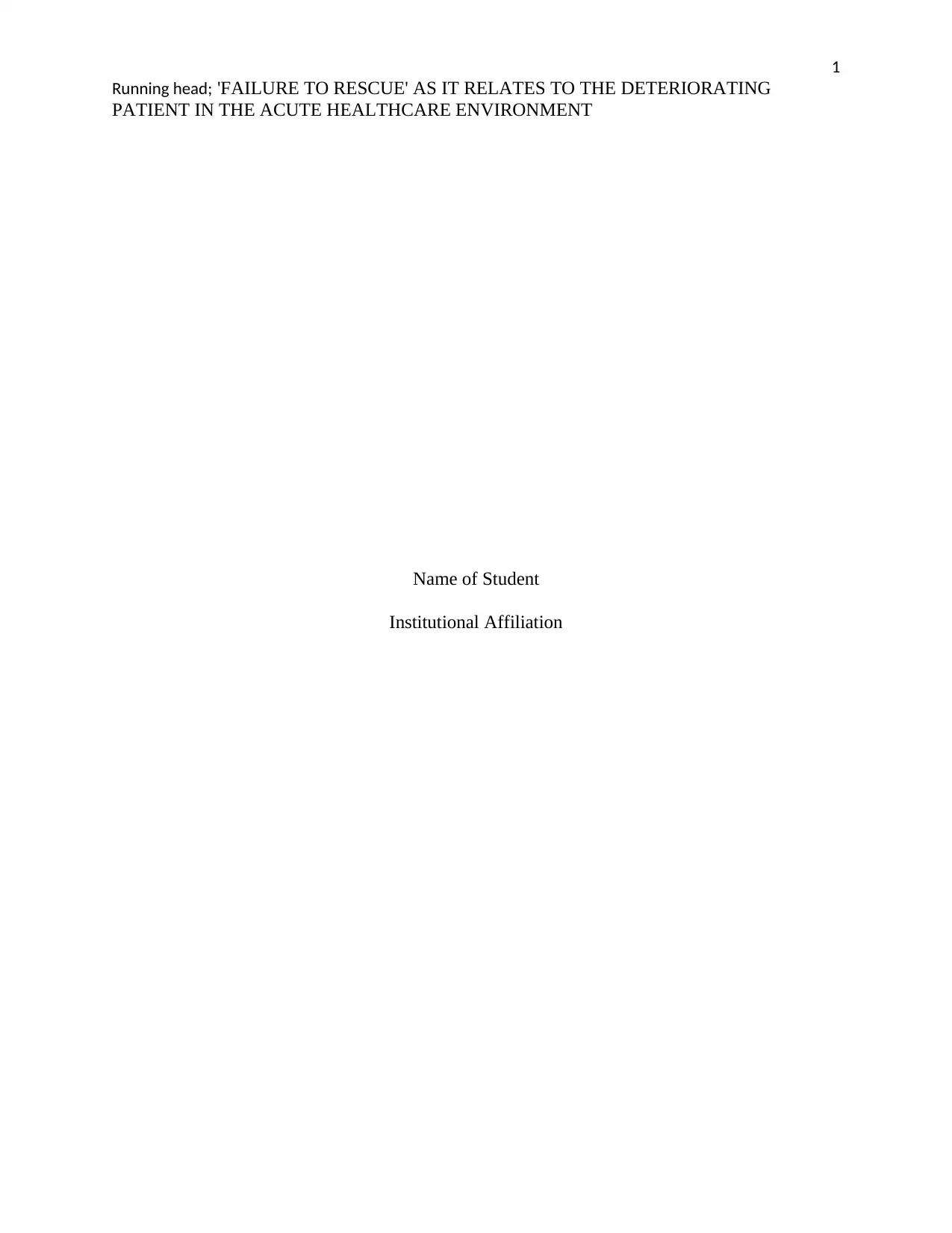
1
Running head; 'FAILURE TO RESCUE' AS IT RELATES TO THE DETERIORATING
PATIENT IN THE ACUTE HEALTHCARE ENVIRONMENT
Name of Student
Institutional Affiliation
Running head; 'FAILURE TO RESCUE' AS IT RELATES TO THE DETERIORATING
PATIENT IN THE ACUTE HEALTHCARE ENVIRONMENT
Name of Student
Institutional Affiliation
Paraphrase This Document
Need a fresh take? Get an instant paraphrase of this document with our AI Paraphraser
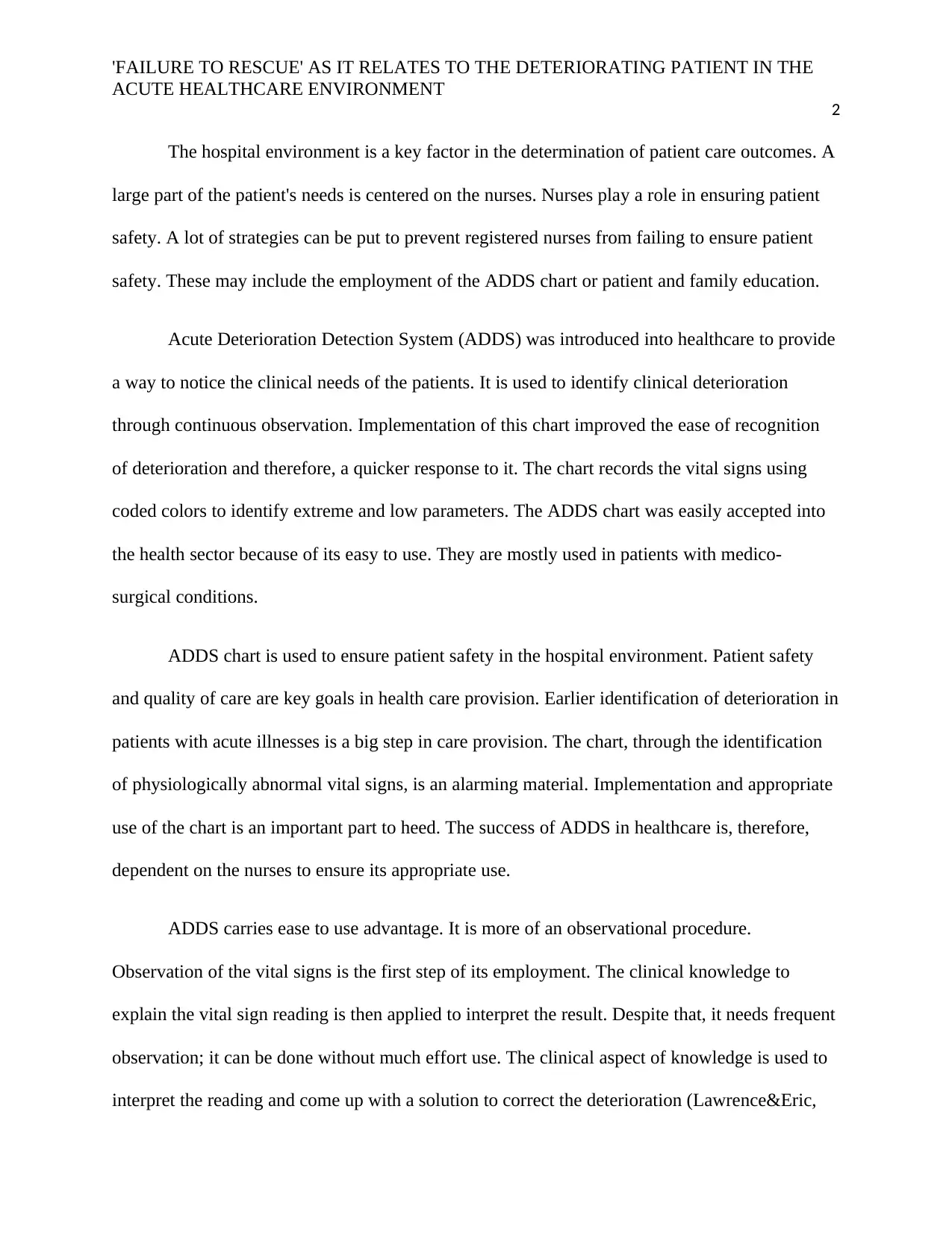
'FAILURE TO RESCUE' AS IT RELATES TO THE DETERIORATING PATIENT IN THE
ACUTE HEALTHCARE ENVIRONMENT
2
The hospital environment is a key factor in the determination of patient care outcomes. A
large part of the patient's needs is centered on the nurses. Nurses play a role in ensuring patient
safety. A lot of strategies can be put to prevent registered nurses from failing to ensure patient
safety. These may include the employment of the ADDS chart or patient and family education.
Acute Deterioration Detection System (ADDS) was introduced into healthcare to provide
a way to notice the clinical needs of the patients. It is used to identify clinical deterioration
through continuous observation. Implementation of this chart improved the ease of recognition
of deterioration and therefore, a quicker response to it. The chart records the vital signs using
coded colors to identify extreme and low parameters. The ADDS chart was easily accepted into
the health sector because of its easy to use. They are mostly used in patients with medico-
surgical conditions.
ADDS chart is used to ensure patient safety in the hospital environment. Patient safety
and quality of care are key goals in health care provision. Earlier identification of deterioration in
patients with acute illnesses is a big step in care provision. The chart, through the identification
of physiologically abnormal vital signs, is an alarming material. Implementation and appropriate
use of the chart is an important part to heed. The success of ADDS in healthcare is, therefore,
dependent on the nurses to ensure its appropriate use.
ADDS carries ease to use advantage. It is more of an observational procedure.
Observation of the vital signs is the first step of its employment. The clinical knowledge to
explain the vital sign reading is then applied to interpret the result. Despite that, it needs frequent
observation; it can be done without much effort use. The clinical aspect of knowledge is used to
interpret the reading and come up with a solution to correct the deterioration (Lawrence&Eric,
ACUTE HEALTHCARE ENVIRONMENT
2
The hospital environment is a key factor in the determination of patient care outcomes. A
large part of the patient's needs is centered on the nurses. Nurses play a role in ensuring patient
safety. A lot of strategies can be put to prevent registered nurses from failing to ensure patient
safety. These may include the employment of the ADDS chart or patient and family education.
Acute Deterioration Detection System (ADDS) was introduced into healthcare to provide
a way to notice the clinical needs of the patients. It is used to identify clinical deterioration
through continuous observation. Implementation of this chart improved the ease of recognition
of deterioration and therefore, a quicker response to it. The chart records the vital signs using
coded colors to identify extreme and low parameters. The ADDS chart was easily accepted into
the health sector because of its easy to use. They are mostly used in patients with medico-
surgical conditions.
ADDS chart is used to ensure patient safety in the hospital environment. Patient safety
and quality of care are key goals in health care provision. Earlier identification of deterioration in
patients with acute illnesses is a big step in care provision. The chart, through the identification
of physiologically abnormal vital signs, is an alarming material. Implementation and appropriate
use of the chart is an important part to heed. The success of ADDS in healthcare is, therefore,
dependent on the nurses to ensure its appropriate use.
ADDS carries ease to use advantage. It is more of an observational procedure.
Observation of the vital signs is the first step of its employment. The clinical knowledge to
explain the vital sign reading is then applied to interpret the result. Despite that, it needs frequent
observation; it can be done without much effort use. The clinical aspect of knowledge is used to
interpret the reading and come up with a solution to correct the deterioration (Lawrence&Eric,
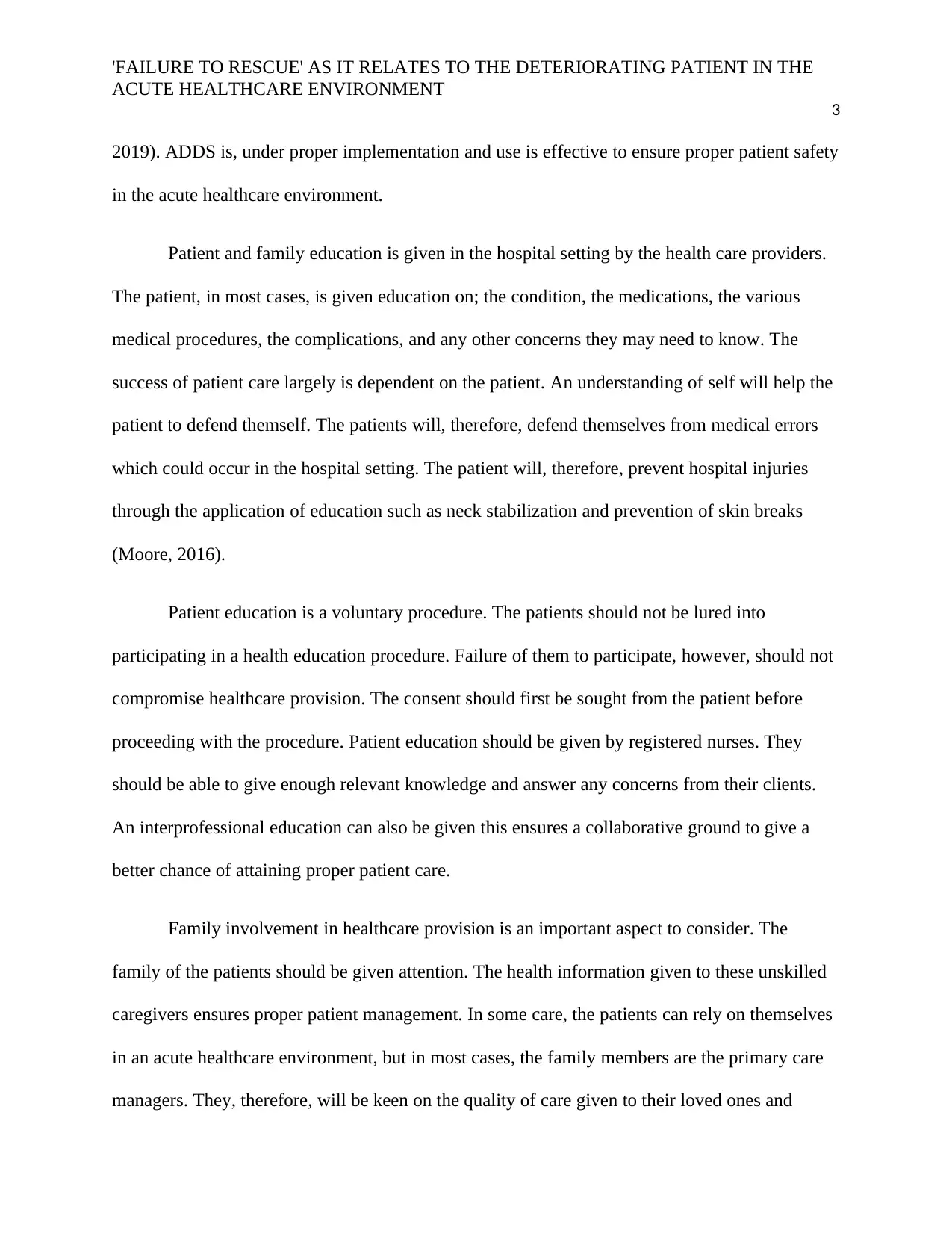
'FAILURE TO RESCUE' AS IT RELATES TO THE DETERIORATING PATIENT IN THE
ACUTE HEALTHCARE ENVIRONMENT
3
2019). ADDS is, under proper implementation and use is effective to ensure proper patient safety
in the acute healthcare environment.
Patient and family education is given in the hospital setting by the health care providers.
The patient, in most cases, is given education on; the condition, the medications, the various
medical procedures, the complications, and any other concerns they may need to know. The
success of patient care largely is dependent on the patient. An understanding of self will help the
patient to defend themself. The patients will, therefore, defend themselves from medical errors
which could occur in the hospital setting. The patient will, therefore, prevent hospital injuries
through the application of education such as neck stabilization and prevention of skin breaks
(Moore, 2016).
Patient education is a voluntary procedure. The patients should not be lured into
participating in a health education procedure. Failure of them to participate, however, should not
compromise healthcare provision. The consent should first be sought from the patient before
proceeding with the procedure. Patient education should be given by registered nurses. They
should be able to give enough relevant knowledge and answer any concerns from their clients.
An interprofessional education can also be given this ensures a collaborative ground to give a
better chance of attaining proper patient care.
Family involvement in healthcare provision is an important aspect to consider. The
family of the patients should be given attention. The health information given to these unskilled
caregivers ensures proper patient management. In some care, the patients can rely on themselves
in an acute healthcare environment, but in most cases, the family members are the primary care
managers. They, therefore, will be keen on the quality of care given to their loved ones and
ACUTE HEALTHCARE ENVIRONMENT
3
2019). ADDS is, under proper implementation and use is effective to ensure proper patient safety
in the acute healthcare environment.
Patient and family education is given in the hospital setting by the health care providers.
The patient, in most cases, is given education on; the condition, the medications, the various
medical procedures, the complications, and any other concerns they may need to know. The
success of patient care largely is dependent on the patient. An understanding of self will help the
patient to defend themself. The patients will, therefore, defend themselves from medical errors
which could occur in the hospital setting. The patient will, therefore, prevent hospital injuries
through the application of education such as neck stabilization and prevention of skin breaks
(Moore, 2016).
Patient education is a voluntary procedure. The patients should not be lured into
participating in a health education procedure. Failure of them to participate, however, should not
compromise healthcare provision. The consent should first be sought from the patient before
proceeding with the procedure. Patient education should be given by registered nurses. They
should be able to give enough relevant knowledge and answer any concerns from their clients.
An interprofessional education can also be given this ensures a collaborative ground to give a
better chance of attaining proper patient care.
Family involvement in healthcare provision is an important aspect to consider. The
family of the patients should be given attention. The health information given to these unskilled
caregivers ensures proper patient management. In some care, the patients can rely on themselves
in an acute healthcare environment, but in most cases, the family members are the primary care
managers. They, therefore, will be keen on the quality of care given to their loved ones and
⊘ This is a preview!⊘
Do you want full access?
Subscribe today to unlock all pages.

Trusted by 1+ million students worldwide
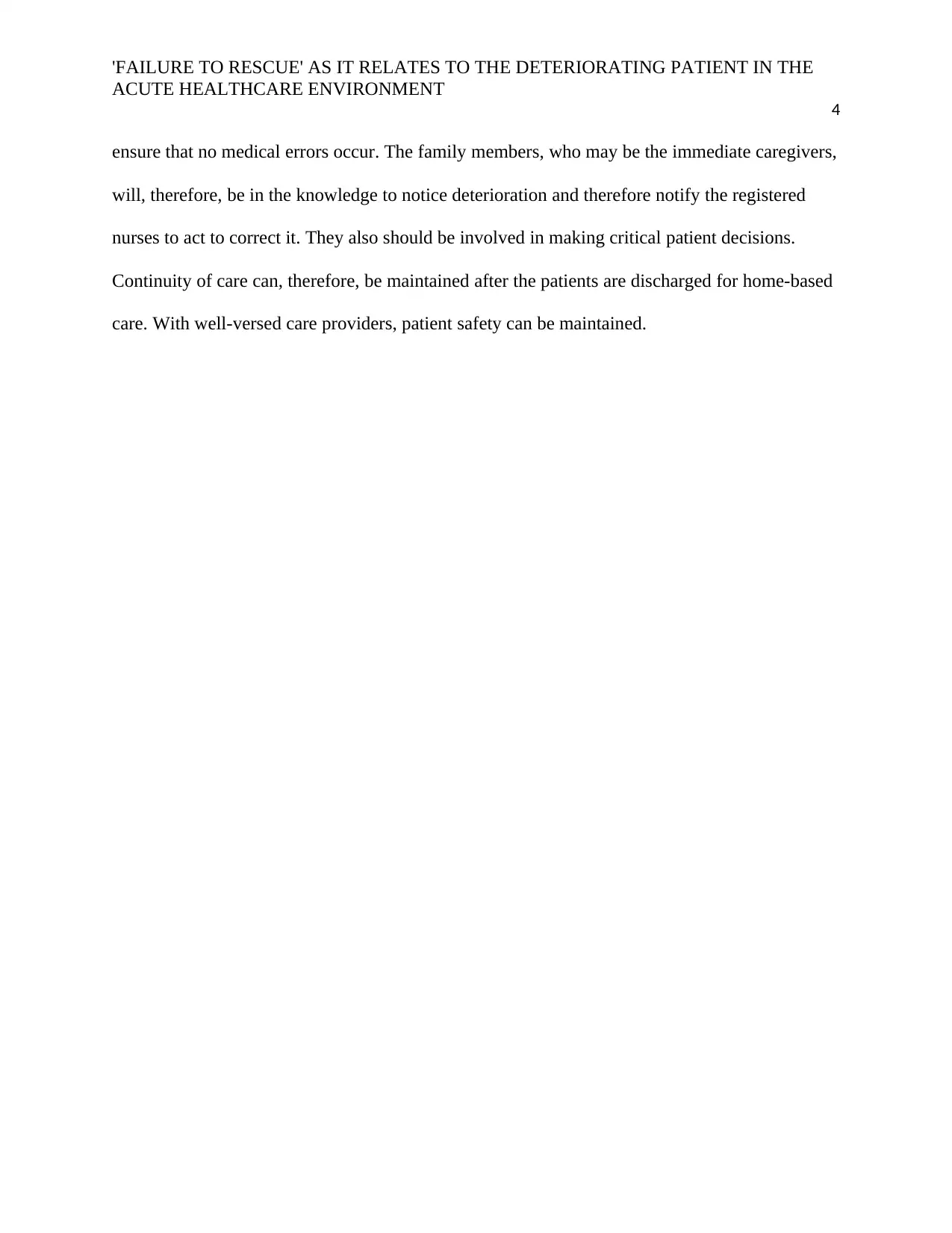
'FAILURE TO RESCUE' AS IT RELATES TO THE DETERIORATING PATIENT IN THE
ACUTE HEALTHCARE ENVIRONMENT
4
ensure that no medical errors occur. The family members, who may be the immediate caregivers,
will, therefore, be in the knowledge to notice deterioration and therefore notify the registered
nurses to act to correct it. They also should be involved in making critical patient decisions.
Continuity of care can, therefore, be maintained after the patients are discharged for home-based
care. With well-versed care providers, patient safety can be maintained.
ACUTE HEALTHCARE ENVIRONMENT
4
ensure that no medical errors occur. The family members, who may be the immediate caregivers,
will, therefore, be in the knowledge to notice deterioration and therefore notify the registered
nurses to act to correct it. They also should be involved in making critical patient decisions.
Continuity of care can, therefore, be maintained after the patients are discharged for home-based
care. With well-versed care providers, patient safety can be maintained.
Paraphrase This Document
Need a fresh take? Get an instant paraphrase of this document with our AI Paraphraser
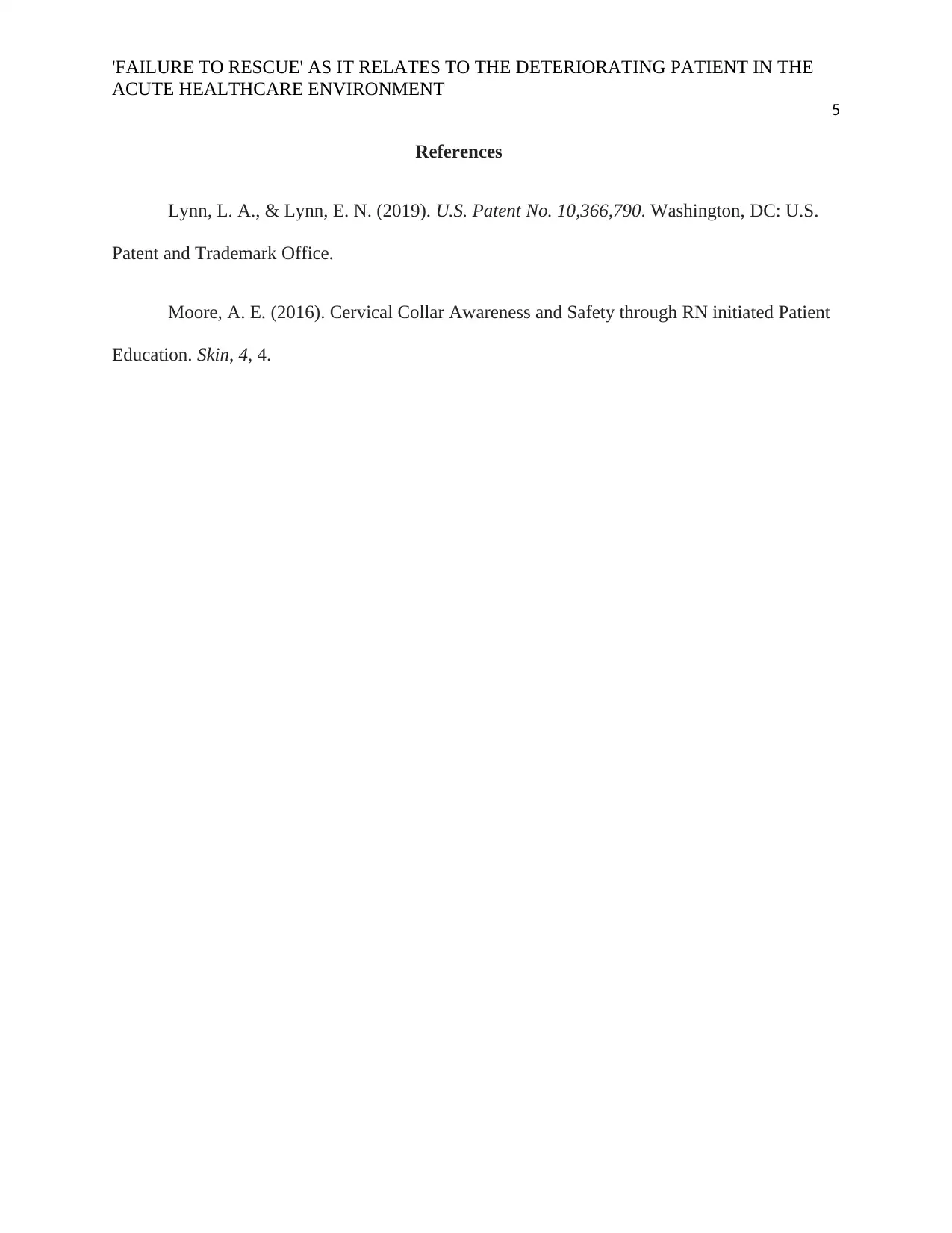
'FAILURE TO RESCUE' AS IT RELATES TO THE DETERIORATING PATIENT IN THE
ACUTE HEALTHCARE ENVIRONMENT
5
References
Lynn, L. A., & Lynn, E. N. (2019). U.S. Patent No. 10,366,790. Washington, DC: U.S.
Patent and Trademark Office.
Moore, A. E. (2016). Cervical Collar Awareness and Safety through RN initiated Patient
Education. Skin, 4, 4.
ACUTE HEALTHCARE ENVIRONMENT
5
References
Lynn, L. A., & Lynn, E. N. (2019). U.S. Patent No. 10,366,790. Washington, DC: U.S.
Patent and Trademark Office.
Moore, A. E. (2016). Cervical Collar Awareness and Safety through RN initiated Patient
Education. Skin, 4, 4.
1 out of 5
Related Documents
Your All-in-One AI-Powered Toolkit for Academic Success.
+13062052269
info@desklib.com
Available 24*7 on WhatsApp / Email
![[object Object]](/_next/static/media/star-bottom.7253800d.svg)
Unlock your academic potential
Copyright © 2020–2025 A2Z Services. All Rights Reserved. Developed and managed by ZUCOL.





